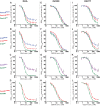Plasmodium falciparum K13 Mutations Differentially Impact Ozonide Susceptibility and Parasite Fitness In Vitro
- PMID: 28400526
- PMCID: PMC5388803
- DOI: 10.1128/mBio.00172-17
Plasmodium falciparum K13 Mutations Differentially Impact Ozonide Susceptibility and Parasite Fitness In Vitro
Abstract
The emergence and spread in Southeast Asia of Plasmodium falciparum resistance to artemisinin (ART) derivatives, the cornerstone of first-line artemisinin-based combination therapies (ACTs), underscore the urgent need to identify suitable replacement drugs. Discovery and development efforts have identified a series of ozonides with attractive chemical and pharmacological properties that are being touted as suitable replacements. Partial resistance to ART, defined as delayed parasite clearance in malaria patients treated with an ART derivative or an ACT, has been associated with mutations in the P. falciparum K13 gene. In light of reports showing that ART derivatives and ozonides share similar modes of action, we have investigated whether parasites expressing mutant K13 are cross-resistant to the ozonides OZ439 (artefenomel) and OZ227 (arterolane). This work used a panel of culture-adapted clinical isolates from Cambodia that were genetically edited to express variant forms of K13. Phenotypic analyses employed ring-stage survival assays (ring-stage survival assay from 0 to 3 h [RSA0-3h]), whose results have earlier been shown to correlate with parasite clearance rates in patients. Our results document cross-resistance between OZ277 and dihydroartemisinin (DHA), a semisynthetic derivative of ART, in parasites carrying the K13 mutations C580Y, R539T, and I543T. For OZ439, we observed cross-resistance only for parasites that carried the rare K13 I543T mutation, with no evidence of cross-resistance afforded by the prevalent C580Y mutation. Mixed-culture competition experiments with isogenic lines carrying modified K13 revealed variable growth deficits depending on the K13 mutation and parasite strain and provide a rationale for the broad dissemination of the fitness-neutral K13 C580Y mutation throughout strains currently circulating in Southeast Asia.IMPORTANCE ACTs have helped halve the malaria disease burden in recent years; however, emerging resistance to ART derivatives threatens to reverse this substantial progress. Resistance is driven primarily by mutations in the P. falciparum K13 gene. These mutations pose a threat to ozonides, touted as promising alternatives to ARTs that share a similar mode of action. We report that DHA was considerably more potent than OZ439 and OZ277 against ART-sensitive asexual blood-stage parasites cultured in vitro We also document that mutant K13 significantly compromised the activity of the registered drug OZ277. In contrast, OZ439 remained effective against most parasite lines expressing mutant K13, with the exception of I543T that merits further monitoring in field-based OZ439 efficacy studies. K13 mutations differed considerably in their impact on parasite growth rates, in a strain-dependent context, with the most prevalent C580Y mutation being fitness neutral in recently culture-adapted strains from Cambodia, the epicenter of emerging ART resistance.
Keywords: K13/Kelch13; Plasmodium falciparum; artemisinin; drug resistance; fitness; gene editing; ozonides.
Copyright © 2017 Straimer et al.
Figures



Similar articles
-
Plasmodium berghei K13 Mutations Mediate In Vivo Artemisinin Resistance That Is Reversed by Proteasome Inhibition.mBio. 2020 Nov 10;11(6):e02312-20. doi: 10.1128/mBio.02312-20. mBio. 2020. PMID: 33173001 Free PMC article.
-
Plasmodium falciparum K13 mutations in Africa and Asia impact artemisinin resistance and parasite fitness.Elife. 2021 Jul 19;10:e66277. doi: 10.7554/eLife.66277. Elife. 2021. PMID: 34279219 Free PMC article.
-
Local emergence in Amazonia of Plasmodium falciparum k13 C580Y mutants associated with in vitro artemisinin resistance.Elife. 2020 May 12;9:e51015. doi: 10.7554/eLife.51015. Elife. 2020. PMID: 32394893 Free PMC article.
-
Profiles of Kelch mutations in Plasmodium falciparum across South Asia and their implications for tracking drug resistance.Int J Parasitol Drugs Drug Resist. 2019 Dec;11:49-58. doi: 10.1016/j.ijpddr.2019.10.001. Epub 2019 Oct 4. Int J Parasitol Drugs Drug Resist. 2019. PMID: 31606696 Free PMC article. Review.
-
Artemisinin Action and Resistance in Plasmodium falciparum.Trends Parasitol. 2016 Sep;32(9):682-696. doi: 10.1016/j.pt.2016.05.010. Epub 2016 Jun 9. Trends Parasitol. 2016. PMID: 27289273 Free PMC article. Review.
Cited by
-
Increased Sensitivity of Plasmodium falciparum to Artesunate/Amodiaquine Despite 14 Years as First-Line Malaria Treatment, Zanzibar.Emerg Infect Dis. 2020 Aug;26(8):1767-1777. doi: 10.3201/eid2608.191547. Emerg Infect Dis. 2020. PMID: 32687050 Free PMC article.
-
Anti-malarial ozonides OZ439 and OZ609 tested at clinically relevant compound exposure parameters in a novel ring-stage survival assay.Malar J. 2019 Dec 18;18(1):427. doi: 10.1186/s12936-019-3056-8. Malar J. 2019. PMID: 31849323 Free PMC article.
-
Evidence for the early emergence of piperaquine-resistant Plasmodium falciparum malaria and modeling strategies to mitigate resistance.PLoS Pathog. 2022 Feb 7;18(2):e1010278. doi: 10.1371/journal.ppat.1010278. eCollection 2022 Feb. PLoS Pathog. 2022. PMID: 35130315 Free PMC article.
-
Protecting future antimalarials from the trap of resistance: Lessons from artemisinin-based combination therapy (ACT) failures.J Pharm Anal. 2021 Oct;11(5):541-554. doi: 10.1016/j.jpha.2020.07.005. Epub 2020 Aug 9. J Pharm Anal. 2021. PMID: 34765267 Free PMC article. Review.
-
Two successful decades of Swiss collaborations to develop new anti-malarials.Malar J. 2019 Mar 22;18(1):94. doi: 10.1186/s12936-019-2728-8. Malar J. 2019. PMID: 30902051 Free PMC article.
References
-
- World Health Organization 2016. Artemisinin and artemisinin-based combination therapy resistance. WHO reference number WHO/HTM/GMP/2016.11 Global Malaria Programme, World Health Organization, Geneva, Switzerland: http://www.who.int/malaria/publications/atoz/update-artemisinin-resistan....
-
- Dondorp AM, Nosten F, Yi P, Das D, Phyo AP, Tarning J, Lwin KM, Ariey F, Hanpithakpong W, Lee SJ, Ringwald P, Silamut K, Imwong M, Chotivanich K, Lim P, Herdman T, An SS, Yeung S, Singhasivanon P, Day NP, Lindegardh N, Socheat D, White NJ. 2009. Artemisinin resistance in Plasmodium falciparum malaria. N Engl J Med 361:455–467. doi:10.1056/NEJMoa0808859. - DOI - PMC - PubMed
MeSH terms
Substances
Grants and funding
LinkOut - more resources
Full Text Sources
Other Literature Sources
Research Materials
